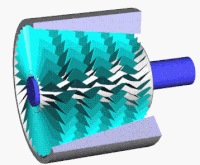
Photo from wikipedia
A two-equation nonlinear reduced-order model is established to describe the interaction between external periodic excitation from a pulsed jet and unsteady flow separation. This model, which is based on a… Click to show full abstract
A two-equation nonlinear reduced-order model is established to describe the interaction between external periodic excitation from a pulsed jet and unsteady flow separation. This model, which is based on a 2D Navier–Stokes equation, the Stuart vortex row model, and the Stuart–Landau model, can approximately describe the typical phenomena occurring in pulsed jet flow separation control. These phenomena include the frequency-dependent, threshold, and lock-on effects, which are related to the frequency, intensity, and phase of excitation. Two indices, namely, the maximum Lyapunov exponent and the entrainment degree, are introduced to identify the mechanism of flow control via external periodic excitation. These indices are used to reflect the order degree and momentum transfer of the flow field. A comparison of the results of the model and those of a numerical simulation in a curved diffuser shows that the nonlinear reduced-order model is effective for qualitatively featuring the behavior of pulsed jet flow separation control. Moreover, the mechanism of pulsed jet flow separation control is explained via the model. Three aspects (i.e., flow instability, flow field ordering, and momentum transfer) are assumed to function together, resulting in an efficient flow control performance.
Journal Title: Proceedings of the Institution of Mechanical Engineers, Part G: Journal of Aerospace Engineering
Year Published: 2022
Link to full text (if available)
Share on Social Media: Sign Up to like & get
recommendations!